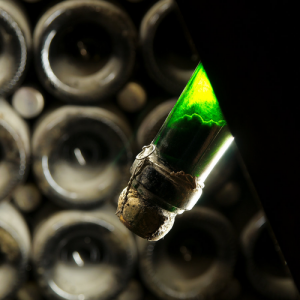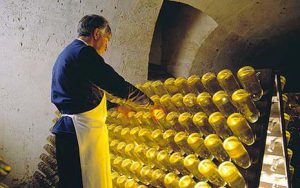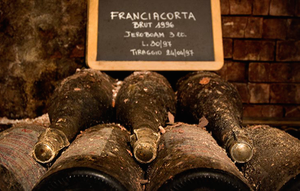
Sparkling Wine in the Champagne Method
Méthode champenoise – no this is not the French rapper the kids are talking about. Like any self-respecting rapper méthode champenoise has many aliases: méthode traditionnelle, traditional method, and metodo classico (Italy) among others.
If you see Méthode champenoise, or any of its aliases, you know that the sparkling wine is made in the traditional method first perfected in Champagne, France.
As you likely know, not all bubbly is Champagne. Champagne is a very well-defined region in the north of France that is known for producing the world’s most famous sparkling wine. (Be sure to check out our Sparkling Wine Primer.)
Much of the world respects the Champagne name and refrains from using the name on its labels. If you see the words Champagne on a bottle of sparkling wine and it’s clearly not French – it’s probably crap. Any respectable sparkling wine producer outside of Champagne would never use the name.
While the name Champagne is exclusive to the region the Champagne Method is used throughout the world. The world’s best sparkling wines are made in this time consuming and labor intensive method.
The Champagne or traditional method requires the finished wine is bottled, in the bottle it will ultimately be sold, along with a dose of yeast, sugar, and nutrients (for the yeast). A secondary fermentation takes place in the bottle. As we all know fermentation results in alcohol and carbon dioxide. Since the CO2 gas has nowhere to escape, it gets absorbed into the wine creating the famous bubbles.
Besides alcohol and bubbles, fermentation also creates sediment as the yeasts multiply. The yeasts do their work and then slumber. This sediment is known as the lees. These lees are also desirable as they contribute to the wine’s flavor. Sitting longer on the lees is desirable and the best bubbly in the world spends at least a year on the lees and in some cases several years.

Riddling Sparkling Wine Bottles
Of course when you buy a bottle of traditional method sparkling wine it is sediment free. The winemaker uses a method known as disgorging to remove the sediment while keeping the clear wine in the bottle.
First, the winemaker places the bottle in a special rack that angles the bottle top and neck downward. Over a period of weeks the bottles are given a turn and a gentle shake to ensure that all of the sediment is collecting at the bottle cap. (They are most frequently capped with a crown cap like beer.) This procedure is called riddling. When the sediment has collected at the cap you may disgorge.
The winemaker dips the neck in a super chilled water bath that freezes the wine and the sediment in the narrow neck of the bottle. The bottle is gently turned upward and the top is popped off releasing the frozen plug of wine and sediment. The bottle is then topped off with wine often containing a dose of sugar to achieve the desired taste. This dosage will determine if a sparkling wine is Brut, Extra Dry, Sec, and so on. (Again, see our Sparkling Wine Primer for a full explanation.)
The World of Sparkling Wine
Of course Champagne can only be made in the Champagne region of France but France makes a lot of sparkling wine throughout the country. When you see the word Crémant on the label you know that it is also made in the traditional method.
A few great examples of traditional method sparkling wine made in France are: Crémant d’Alasce, Crémant de Loire, Crémant de Bourgogne, and Crémant de Jura among others.
A famous French sparkling wine, and perhaps the first, is Blanquette de Limoux. This sparkling wine was not made in the traditional method rather the ancestral method. With the ancestral method there is no secondary fermentation. The wines are bottled before fermentation is complete. By finishing the wine in the bottle the carbonation is captured in the bottle and the wine. Today wines in this style are made under the AOC Limoux Méthode Ancestrale.
Many other nations also produce traditional method sparkling wines. Winemakers in the USA create hundreds of examples from New York to California and most everywhere in-between.
Spain famously produces Cava – a great sparkling wine made in the traditional method and often at a fraction of Champagne’s asking price. Cava remains a tremendous value often being sold for less than Prosecco — a famous sparkling wine not made in the traditional method. Cava is most often made with native grapes such as Macabeo (aka Viura), Xarel-lo, Parellada, Subirat Parent, Garnacha, Trepat, and even Monastrell. However, Chardonnay and Pinot Noir are also utilized in the production of Cava and savvy buyers can find Rosé Cava made with 100%, or primarily with Pinot Noir selling for well under $20.

Italy’s Great Sparkling Wine – Franciacorta
In Italy in the northern region of Lombardy are found the two DOCG appellations (see our Italian Wine Primer for a full explanation) of Franciacorta and Oltrepo Pavese Metodo Classico. Also in the north in the Trentino-Alto Adige is the appellation Trento DOC or simply Trentodoc and in Piedmont the bubbly made in Alta Langa DOCG having been growing in popularity.
Italy’s best known sparkling wine is Prosecco. Prosecco is not made in the traditional method rather the Charmat or tank method. In this method the wine also undergoes a secondary fermentation but does so in a tank. Then the sparkling wine is drawn off the sediment and bottled. This method can produce very nice sparkling wines but they rarely have the depth of traditional method sparkling wines.
In Germany they make a sparkling wine known as Sekt. Sekt can be made in the traditional method or the tank method. Check out the bottle carefully before buying.
I hope that your sparkling wine knowledge is a more robust and most of all I hope that you’re thirsty. Go out and explore.

I’m pretty sure Blanquette de Limoux is done in Methode Traditionelle…
Brian, yes there are wines in Limoux made in what now known as the classic method. The original Blanquette de Limoux was made in the ancestral method as described in the story. Today Limoux wines made in this method are made under the Limoux Méthode Ancestrale AOC. Limoux Blanquette de Limoux AOC is made in the classic/traditional method and allow up to 10% of Chenin Blanc or Chardonnay along with the traditional Mauzac. To further confusion things there is also the AOC of Crémant de Limoux that flips the blend with Chenin Blanc and/or Chardonnay in the lead with lesser amounts of Pinot Noir and Mauzac made in the classic method.